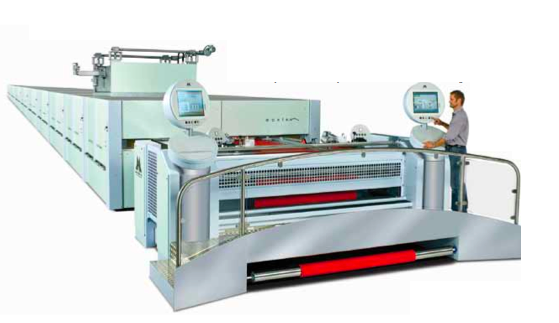The Noman Group, one of the largest vertically integrated textile producers in Bangladesh and in 2010 the country’s biggest exporter of garments, has added a new Monforts Montex stenter to its line-up as part of massive investment aimed at keeping the group in its premier position.
 Originally founded as a trading company in Dhaka in 1968 and which now owns 19 mills and employs a workforce of more than 40,000, Noman is Monforts’ largest customer in Bangladesh.
Originally founded as a trading company in Dhaka in 1968 and which now owns 19 mills and employs a workforce of more than 40,000, Noman is Monforts’ largest customer in Bangladesh.
The new Montex 6500 stenter was supplied and installed by the Monforts representative, Bengal Technological Corporation, at the Noman Weaving Mills plant at Sreepur, on the outskirts of Dhaka.
Noman already uses a range of Monforts technology in its continuous dyeing and sanforising lines with Monfortex and Toptex shrinkage units for woven and knitted fabrics. These sanforizers offer increased residual shrinkage, higher production speeds, and reduced water consumption for cooling and substantial time savings for blanket changes.
Mr. Gabriel Tagasa, advisor at the group’s multiple outlets in the Sreepur Zone, said that Noman invested in new equipment throughout 2010 to expand spinning and dyeing capacity at its woven and knit garment units, ensuring that the group has the capacity to maintain its position as a major exporter.
Installing the new Monforts 6500-6F stenter, which joins two other Monforts stenters, will allow Noman to step up its output of dyed and knitted fabrics and offer faster and more flexible production times to its customers.
“All our work is exported,” says Mr. Tagasa. “Consequently, the Montex 6500 is an important investment for us. It adds to the enormous flexibility we already have, which is substantially based on our existing Monforts technology. A lot of our customers are producing niche fashion items, sportswear and so on, often in relatively small production runs. We can therefore produce what is needed to meet their design and quality criteria”.
Meeting costs is also extremely important during this period of intensely tough competition, and the company wants to stay ahead of its domestic competitors as well as international producers.
Mr. Tagasa further says: “We work very closely with Bengal Technologies and Monforts to achieve this, and regard our relationships as a real working partnership. In addition to the size and capacity of the Montex 6500, we are very impressed by the machine’s energy saving operation. There is a great shortage of energy supply in our country, and although we are fully backed up by generators, we are always very conscious of the need to reduce our energy consumption.”
Noman has leapt into the first place from its previous position in the number three slot, benefiting from the global slowdown that has created a windfall for Bangladesh textile importers in general. With $400-$420 million worth of exports in 2010, Noman has ended a long-held domination by the Opex Group and the Nassa Group.
“The global downturn prompted many top low-cost retailers to search for more economical supply sources,” says Mr. Tagasa. “Since we operate on economy of scale and with very low profit margins, we are receiving increased orders from top retailers like Asda, Wal-Mart and Target.”
The group’s spinning mills have 463,600 spindles manufacturing from 8/s to 80/s counts both in carded and combed forms, supporting both the local and export markets.
In the home textiles sector, Noman is the largest producer in Asia and one of the biggest in the world, exporting to Europe and North America generally, with leading names like H&M, M&S, IKEA, Wal-Mart, Asda, Carrefour, Aldi, Lidl, and JYSK amongst its customers.
In apparels, the company is greatly increasing its production capacity for twill, poplin, canvas and yarn dyed fabrics and will be launching a new product line in denim, towel and jersey knitted fabrics.
The company is now expanding its woven and knit garment units, adding a new 75,000 spindle spinning mill and an additional 100,000 m2 of fabric dyeing and finishing units. It is also investing in new poplin, bed-net, terry towel and home textile facilities.
Bangladesh’s more than 2,500 active garment and textile manufacturers exported $11 billion worth of knit, woven and home textile items in 2009, with only a handful exporting over $100 million or more.
Cotton prices have increased significantly in the last two years, but retailers and end customers were unwilling to raise their prices. In terms of pricing, however, Bangladesh is competitive due to the low wage economy. The quality of products made in Bangladesh has also improved greatly, especially with those manufacturers who have recently invested in European technology.
Noman has been able to build on these advantages by enacting new strategies such as cost minimisation in different areas of production, increasing value-added products, product diversification, segmenting the products, opening new markets, and development of new products offering better margins.
A few years ago, European and North American customers thought Bangladesh was unable to turn out quality products, but now they are buying more from Bangladesh because of the price and quality of the textiles.